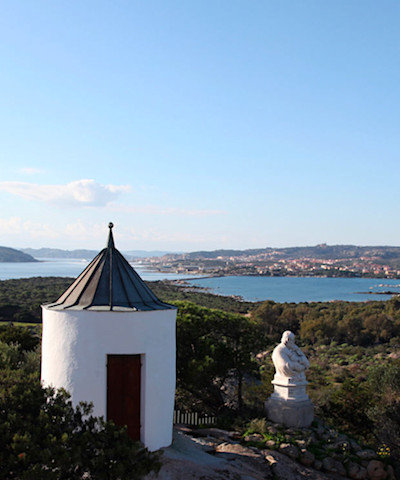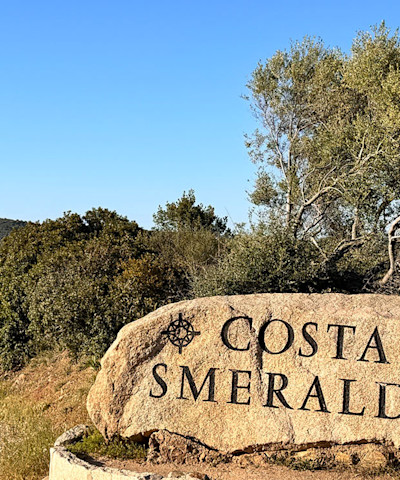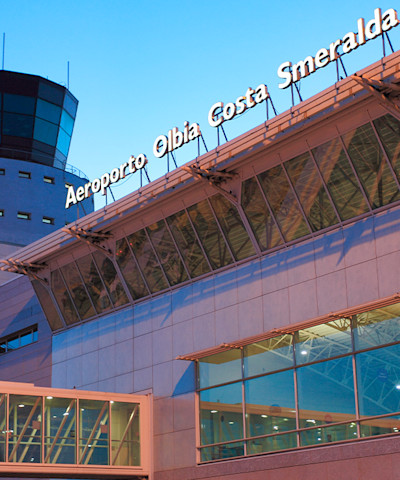Emerald Coast®, how to reach the most beautiful beaches
From Cala dei Ginepri to Rena Bianca: all the information and useful tips for visiting your favorite beaches
The Costa Smeralda® is a precious hidden gem of Sardinia that enchants visitors every year with its paradisiacal beaches, crystalline waters, and panoramic views of breathtaking landscapes. Its beaches, which stretch for 55 kilometers along the Gallura region in the northeast of the island, reaffirm themselves as one of Italy's most exclusive and fascinating tourist destinations, as well as one of the most beloved seaside destinations internationally.
Also known as the Coast of Dreams, the Costa Smeralda® gained fame starting from March 14, 1962, the year of the official establishment of the Costa Smeralda Consortium, thanks mainly to the impetus and far-sighted project of Prince Karim Aga Khan IV, who contributed to transforming this area into an oasis of luxury and natural beauty. It's no coincidence that even today the Costa Smeralda® continues to be a coveted destination for travelers from around the world, drawn by the unique combination of elegance, relaxation, and outdoor adventures.
Surrounded by hills covered with Mediterranean scrub, smoothed granite rocks sculpted by wind and sea, and lush, wild vegetation, the beaches in the area are famous for their fine, white sand resembling snow and their crystal-clear waters. Each beach has its charm and unique personality: the protected and intimate bays, characterized by calm, shallow waters and ample space on the shore for sunbathing, are the ideal choice for families with children or those seeking a tranquil and relaxing environment. Meanwhile, beaches often associated with the massive presence of the Italian and international jet set, such as Spiaggia del Principe, Capriccioli, Pitrizza, Rena Bianca, and Romazzino - just to name a few - are the cool destinations for young people eager to experience an unforgettable adventure and, in general, for all those who want to dive headfirst into Sardinia's nightlife scene.
Cala dei Ginepri
The Cala dei Ginepri, traditionally also known as Cala di Nibbari - since "nibbaru" in the Gallurese dialect means juniper - is located along the provincial road that connects Baja Sardinia to the Gulf of Arzachena. Here, more precisely at the eastern end of Cala dei Ginepri and just after the beach of Saline, you'll find the so-called Ea Bianca Beaches (East and West), which are two small coves (twins in size) framed by a small promontory of white rocks smoothed by the action of the waters and by a fragrant pine forest of junipers. This pine forest not only provides some coolness during the hottest hours of the high season but is also the ideal place for the few visitors eager to organize a picnic in total tranquility and privacy. Thanks to its west and northwest exposure, Cala dei Ginepri is also quite sheltered from the scirocco and east winds. The shoreline, composed of golden and coarse sand grains, has a shallow and sandy seabed, making this beach ideal for families with children and for those who want to engage in various sports activities such as snorkeling, diving, underwater fishing, surfing, and so on. Cala dei Ginepri offers its bathers a series of essential services for a relaxing and fun day at the beach. In addition to the possibility of enjoying various dining services, visitors can also rent umbrellas and sun loungers, pedal boats, and jet skis. Pets are not allowed, and the paid parking, which is in the immediate vicinity, is also suitable for camper vans.
How to get there? The Cala dei Ginepri beach is easily accessible by car. Starting from Olbia, heading north towards Arzachena - Baja Sardinia, you'll reach your destination in 34 minutes by first taking the SS125 Orientale Sarda (20 kilometers) and then the SP59bis towards via Cala dei Ginepri. From Golfo Aranci, the quickest route (36 minutes) is via the SP73. From the SP59bis, once you reach the junction with via Lu Nibbaru, turn left following the sign for Cala dei Ginepri engraved on a granite rock. Then, drive the last 800/850 meters down a steep road towards the coast to reach an asphalted and unguarded parking area where you can park motorcycles, cars, and campervans. Just before reaching the parking area, immediately after the speed bumps, a path begins through a pine forest, ending with convenient wooden steps behind the beach. From June to September, and from Monday to Sunday, Arzachena operates its local public transport service called Lu Pustali, which includes Line Smeralda 1 (green line), connecting its municipality to Porto Cervo and the beaches of the Costa Smeralda®. Cala dei Ginepri beach can be reached by taking this bus and getting off at the Pulicinu stop, which is in the immediate vicinity of the Hotel La Rocca Resort & Spa (SP59bis). Then, it's a long walk (two kilometers in total) to reach the beach.
Pitrizza
The beach of Pitrizza, located near the village of Liscia di Vacca, along the northeastern coast of Sardinia between Baja Sardinia and Porto Cervo, takes its name from tiny pebbles that mark the boundary between the shoreline and the vegetation. It is a small-sized beach (200 meters), with coarse-grained sand in cream and pink hues, dotted with rocks, emerald sea, and a sandy and pebbly seabed with protruding rocks. The beach, entirely occupied by the facilities of the eponymous Hotel Pitrizza, one of the most famous and luxurious five-star hotels on the coast, is not accessible by car, and visitors cannot sunbathe or swim there. However, it is possible to take an exploratory walk in the surrounding area. In this short stretch of coastline, the hotel cannot be seen from the sea, land, or sky, as it blends seamlessly with nature. It offers a beautiful view of the Maddalena Archipelago and provides exclusive services for its clients, including a bar and restaurant, a rental service for sun loungers and umbrellas, and another for renting equipment for water sports. With all these amenities, the beach is also suitable for children. Pets are not allowed.
How to get there? From Olbia, Pitrizza beach is reachable by car by first driving 15 kilometers on SS125 Orientale Sarda towards Arzachena, then taking the coastal road (SP73) towards Porto Cervo. From there, continue on SP59, following signs first for Liscia di Vacca, and then for Baja Sardinia - Pitrizza. After passing the turnoff for the Pitrizza locality, and driving 600 meters from the granite boulder with the symbol of the Costa Smeralda Consortium, you'll find a wide spot on the right side of the road with the symbol of Poltu Quatu. At this point, take the road that runs parallel to the main road, which, in 400 meters, leads you to the inlet where the Poltu Quatu fraction is located. Just after the port, turn left towards the Hotel Pitrizza (via la Banchina di Pitrizza s.n.c.). Pitrizza beach can also be reached by the local bus service Lu Pustali: starting from the Porto Cervo center Terminal, get off at the "Liscia di Vacca" stop and continue on foot for 1.7 kilometers
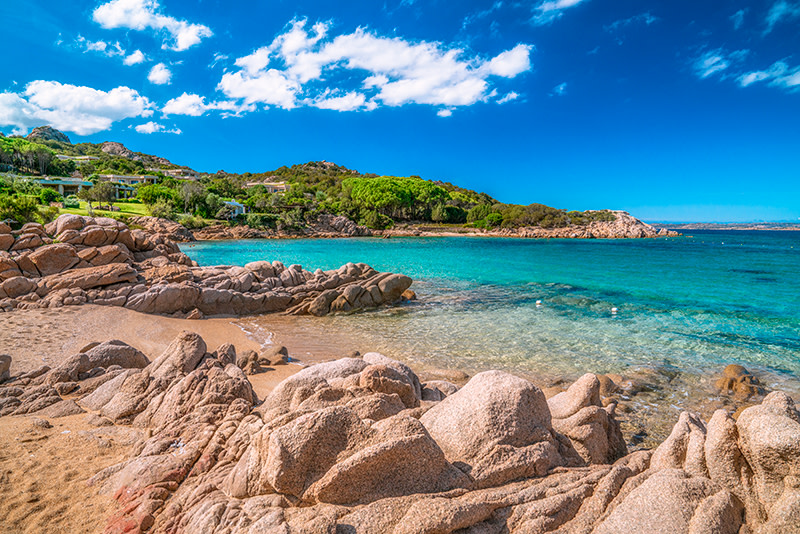 Spiaggia di Pitrizza
Spiaggia di PitrizzaCala Granu
Cala Granu, one of the most beautiful bays in the northeast of Sardinia, is just a few minutes' drive from the Marina di Porto Cervo. With a length of 80 meters and a width of about 20 meters, the beach has a surface area of 1600 m2 and is freely accessible - it can accommodate a maximum capacity of 200 people - and is composed of very fine white sand. It is enclosed on the sides by two rocky shores that protect it from the wind and surrounded at the back by a vast Mediterranean scrubland, giving it a picturesque setting. The beach is bathed in front by unparalleled sea, whose crystal-clear waters, depending on the exposure to sunlight, take on colors ranging from deep blue to emerald green. Thanks to a predominantly shallow and sandy seabed, Cala Granu is an ideal destination for families with children. During the summer season, beachgoers can enjoy the spectacle of sailboats anchored offshore, with a panoramic view of the Capo Ferro lighthouse, and make use of numerous services including the rental of sun loungers, umbrellas, and pedal boats, a free or paid freshwater shower service, the presence of a lifeguard ensuring beach safety, and two parking areas - a paid one near the beach and a free one not too far away. Pets are not allowed.
How to get there? From Arzachena, take the SS125 Orientale Sarda southbound towards Olbia. After approximately 5 kilometers, turn left onto SP73 following signs for Baia Sardinia. After another 2 kilometers, at the roundabout, take the third exit onto SP59 towards Baia Sardinia and Porto Cervo, and continue for about 18 kilometers. Upon reaching Porto Cervo, turn right onto Via della Marina towards Porto Cervo Marina and follow the signs for Capo Ferro. A little further north, after about 500 meters, turn right onto Via Cala Granu near the holiday complex of the same name. From here, you'll need to park your car in the available parking area and reach the beach on foot (about a 300-meter walk). The beach can also be reached by the Lu Pustali bus: departing from the Porto Cervo Centro Terminal, get off at the first stop Incrocio Porto Cervo Marina and arrive at the destination after a long walk, or by sea with small private or rental boats, using one of the launch corridors available on the shore.
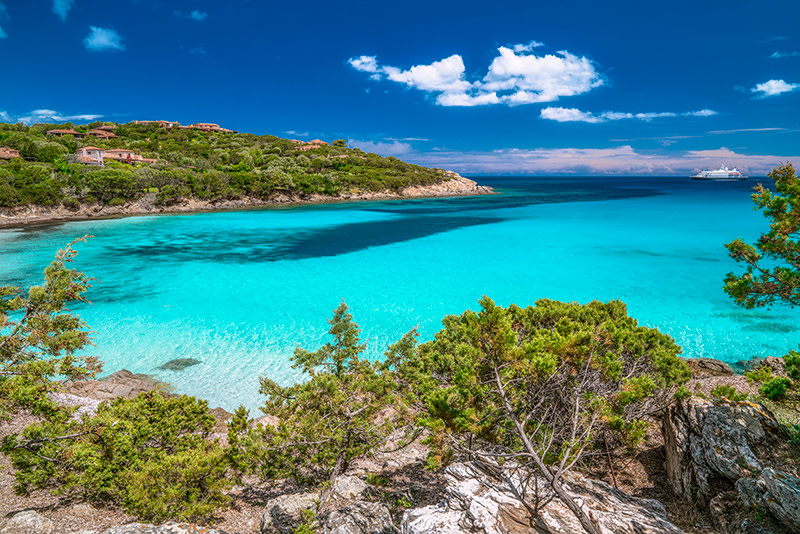 Cala Granu
Cala GranuPiccolo Pevero
In the northeast of Sardinia, just south of Porto Cervo, lies the Gulf of Pevero, a bay of extraordinary beauty traversed by the river La Pedralonga and offering breathtaking views of the charming panorama of the Li Nibani islands (meaning seagulls), so named for the massive presence of seagull flocks. The natural architecture of the Gulf has favored the formation of numerous small secluded coves and, above all, two beloved beaches: Grande Pevero and Piccolo Pevero. Located in the central part of the gulf, Piccolo Pevero beach is a medium-sized beach protected at the back by some ancient juniper trees. Part of it is entirely free, while another part is managed by beach resorts that offer rental services for sun loungers, umbrellas, and pedal boats, along with refreshment points such as shaded areas where you can enjoy refreshing drinks and snacks, and restaurants for a seaside lunch with a view. The beach, composed of very fine white sand, is framed by small cliffs emerging from crystal-clear azure-green emerald waters, making it particularly suitable for families with children due to its shallow waters. The orientation of the beach ensures protection from winds coming from the west and south. Pets are not allowed.
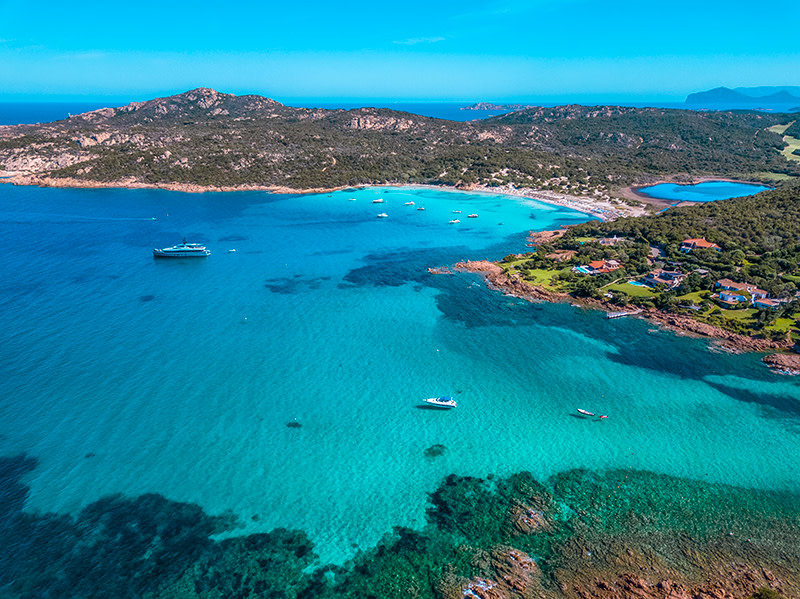 Piccolo Pevero
Piccolo PeveroGrande Pevero
Within the natural area of Monti Zoppu and a short distance from Piccolo Pevero, lies Grande Pevero, a spacious beach with an unmistakable crescent shape and fine, white sand. The sea colors range from turquoise to emerald, and the sandy, shallow seabed is suitable even for the youngest visitors, allowing them to enjoy relaxing walks in the water while admiring the Li Nibani islands in the distance. The beach is sheltered from southern winds, providing bathers with relief from the scirocco on hot days. Along the beach, both free and equipped areas are available, with facilities and refreshment points. Visitors can rent sun loungers, deck chairs, umbrellas, pedal boats, canoes, and stand-up paddleboards. Pets are not allowed, and parking, with 80 spaces available, is subject to a fee. Behind Grande Pevero beach, you'll find Padula Saloni, a small freshwater pond where birdwatching enthusiasts and experts can admire various species of waterfowl stopping by to drink. Additionally, the renowned Pevero Golf Club, a splendid 18-hole golf course, awaits golf enthusiasts. From here, you can embark on the Pevero Health Trail, a health trail immersed in the Monti Zoppu promontory, which connects the Gulf of Pevero to Romazzino beach and Cala Liccia through two types of trekking paths: the Relax trail marked with red signage, and the Energy trail marked with yellow signage, suitable for cycling.
How to get there? The beaches of Piccolo and Grande Pevero, located 16-17 minutes from Arzachena and 3 kilometers from Porto Cervo, are situated close to each other. Both are accessible by taking the SP59 between Abbiadori (a hamlet of Arzachena) and Porto Cervo heading south. After passing through the built-up area of Abbiadori, continue straight on the main road for about 3 kilometers. At the intersection of Via della Conchiglia/Piccolo Pevero, turn left where the sign for Piccolo Pevero is carved into the rock. After just 350 meters, turn slightly right onto Via della Conchiglia to enter a large paid parking area, where you can leave your car and walk along the road lined with entrances to some villas until you reach a metal barrier that separates the asphalt road from the dirt road. From the parking lot, it takes only five minutes on foot to reach Grande Pevero beach (on the right) and Piccolo Pevero beach (on the left). You can also reach the beaches by Lu Pustali bus and get off at the Incrocio Piccolo Pevero stop.
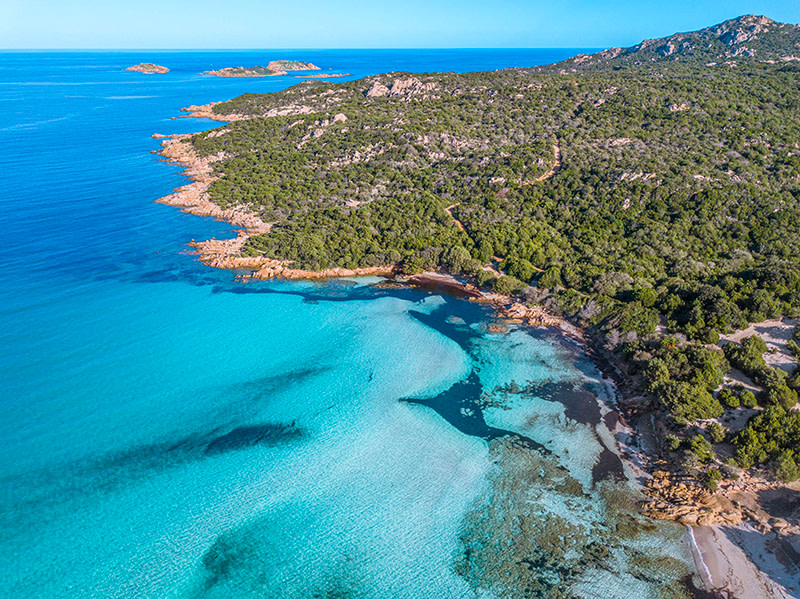 Grande Pevero
Grande PeveroRomazzino
Romazzino beach is considered one of the most beautiful beaches in the area, nestled between Punta Capaccia to the north and Punta Romazzino to the south. In its immediate vicinity are also the Prince's beach and Piccolo Romazzino, a small inlet of 120 meters surrounded by picturesque green hills. Romazzino takes its name from rosemary (romazzinu in Gallurese dialect becomes zippiri in the south of Sardinia), the characteristic aromatic plant of the Sardinian Mediterranean scrubland that surrounds the entire sandy area. It is a beautiful white beach but, unlike most beaches in the area, it has rather grainy sand. The shallow seabed makes it ideal for children, while its crystal-clear and transparent sea takes on all the most beautiful shades of blue and green. Romazzino beach, although open and airy, remains sheltered from the Mistral wind. It is also quite large (about 300 meters long), although much of it is occupied by umbrellas from the eponymous and historic 5-star hotel, an architectural masterpiece built in 1965 in Mediterranean style entirely in white by architects Michele and Giancarlo Burisi Vici. In addition to the beach area reserved for guests of the Hotel Romazzino, the beach also has ample areas equipped with umbrellas and sun loungers from beach clubs open to all. From the surroundings of Romazzino beach, two trails of the Pevero Health Trail start: trekking routes of fairly easy level, thanks to which walking enthusiasts have the opportunity to explore the territory. Pets are not allowed, and parking, with 25 parking spaces available, is subject to a fee.
How to get there? Leaving the SP59, from Porto Cervo, head south along the provincial road 94. In the area of Abbiadori, turn at the junction for Cala di Volpe and continue towards Romazzino along the SP160. Before reaching Capriccioli, turn left onto Via Romazzino. You'll find yourself on a long straight road through the countryside where a long promenade has recently been built. To reach Romazzino beach, you'll then turn right onto Via degli Asfodeli and continue straight for about 100 meters before reaching the paid parking area located behind the beach. Romazzino beach is not accessible by the Lu Pustali bus (the nearest stop is Capriccioli).
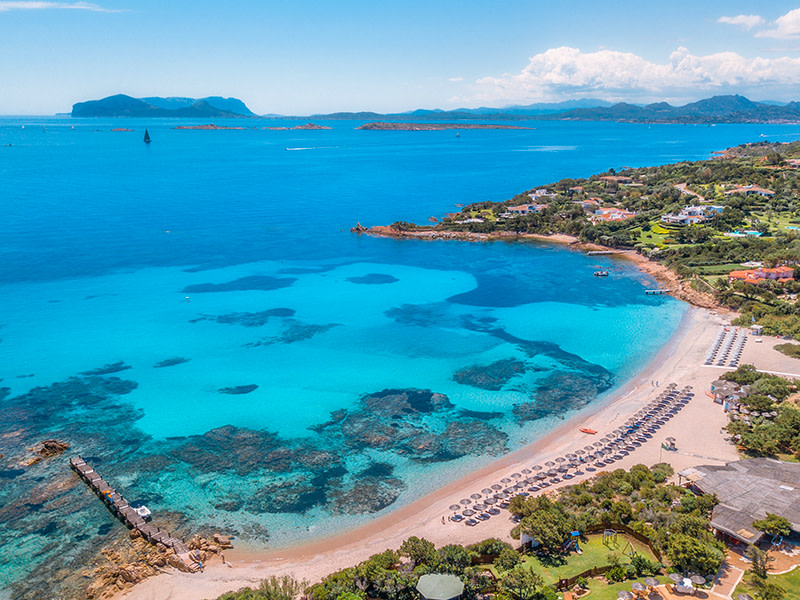 Romazzino
RomazzinoSpiaggia del Principe
La spiaggia del Principe, known by the Sardinians as Poltu di Li Cogghj, meaning "Port of the Skins," as it was originally used to ship leather and local manufactured goods, owes its name today to the Arab prince and Muslim imam Karim Aga Khan IV, the driving force behind the tourist development of the Costa Smeralda®, who is said to have favored the beach. In the sixties, Aga Khan accidentally arrived at Porto Cervo, in a stretch of Sardinia that was then wild and beautiful, a rough diamond wrapped in the scents of the Mediterranean scrubland, and fell madly in love with it. He decided to build what is now the Costa Smeralda®, hiring Sardinian architects and artisans and drawing inspiration from ancient Sardinian constructions (such as nuraghi) to create his structures. The Prince himself chose Poltu di Li Cogghj for the construction of one of his villas, which was ultimately never built. Surrounded by dense Mediterranean vegetation that gives it the shape of a large arch, the Principe beach owes its beauty to its two stretches of extremely fine white sand, separated by a promontory of pink granite rocks and bathed by transparent and shallow water. The clarity of the sea, whose color touches all shades from turquoise to emerald green, is due to the shallow seabed of white sand and granite, which has the peculiarity of not turning into powder, and therefore not clouding the waters. Being exposed to the southeast, it is recommended to visit the beach on days when the wind blows from the west. The Principe beach is open to everyone: it is possible to rent sun loungers and umbrellas at the small establishment, which also has a small refreshment area. It is one of the most popular beaches and a favorite destination for young couples and families with children, especially thanks to its shallow seabed and its view of the island of Mortorio. Pets are not allowed, and parking, with 25 available parking spaces, is subject to a fee.
How to get there? From Arzachena, take SP59 towards Porto Cervo. After 13 kilometers, at the roundabout, take the first exit to enter SP94 towards Cala di Volpe. Continue on provincial road 94 for 2.5 kilometers and before reaching Capriccioli, turn left onto via Romazzino. From Olbia, take SS125 Orientale Sarda. At the Piliezzu roundabout, take the first exit towards Palau. Continue on SP73 for another 7.6 kilometers. At the San Pantaleo junction, keep right to enter SP94, direction Cala di Volpe, and continue for about 8 kilometers, until via Romazzino. At this point, the road is the same whether you are coming from Olbia or Arzachena: continue straight towards the sea and, after about 300 meters on a dead-end road downhill, you will reach a barrier that closes the car entrance. Here you will find a paid parking lot. Once parked, to reach the Principe beach, you will need to walk along a path of about 300 meters, approximately 8-10 minutes of walking on terrain partly asphalted and partly dirt among lush Mediterranean vegetation. The Principe beach is not accessible by the Lu Pustali bus (the nearest stop being Capriccioli and a long walk away).
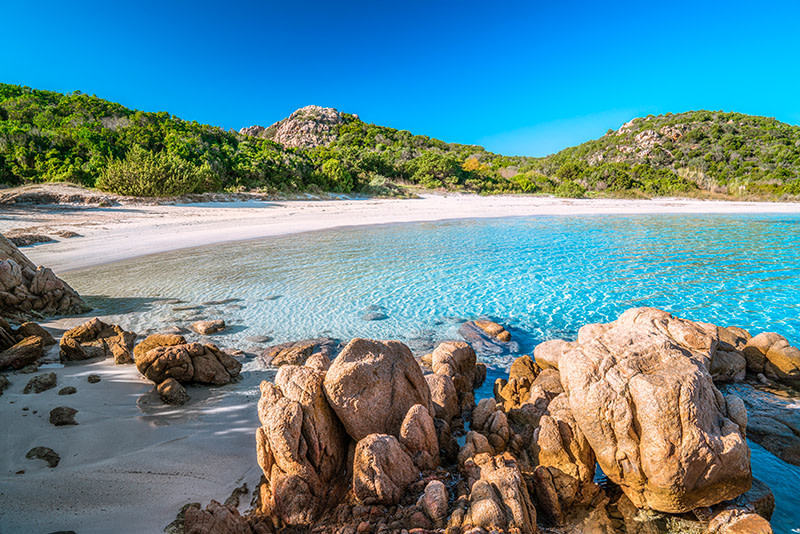 Spiaggia del Principe
Spiaggia del PrincipeSpiaggia Capriccioli
Cala Capriccioli, located just a short distance from the homonymous town of Capriccioli, forms four beautiful coves, two on the east side and two on the west side, all well protected from the northwest winds. On the western side, huge granite boulders separate the Pirate Beach from the Turtle Beach: the former is the largest and is named after the beach bar restaurant present there, while the latter owes its name to the sea turtles that come here to lay their eggs. The eastern side, surrounded by abundant Mediterranean vegetation with lentisks and junipers, is formed by two equally stunning beaches, simply named Capriccioli Public Beach and Capriccioli East Beach. All the coves are highly appreciated by families with children: the beaches are easily accessible on foot and are separated by a pine forest and low, smooth granite rocks that emerge everywhere in the surroundings. The very fine and white sand, with light gray shades, sinks into crystal-clear, shallow waters that vary in color from emerald green to deep azure. Cala Capriccioli is a well-known and highly frequented beach. There are numerous services available for bathers: you will find an info point, umbrella and sunbed rental, and refreshment points. Pirate Beach also has a wooden pier for renting and mooring rubber boats, canoes, and pedal boats. Animals are not allowed, and the paid parking has 5 available spots on asphalt and another 5 on unpaved ground. The beauty of Capriccioli is also due to its proximity to numerous islands: Mortorio, Soffi, and Camere are part of the National Park of the La Maddalena Archipelago, a small natural oasis accessible by small boats, pedal boats, and canoes departing from the pier of Pirate Beach.
How to get there? From Porto Cervo, leaving the SP59 that continues towards Arzachena, at the roundabout take the third exit to enter the SP94, heading towards the village of Abbiadori. After passing through the inhabited center, continue straight on the SP160 towards Capriccioli, Cala di Volpe, and the homonymous hotel for 2 kilometers. Once past the junction for via Romazzino, after about a kilometer, you will find paid parking lots on either side of the road at Capriccioli. The beach is also accessible by the Lu Pustali bus, with a stop at Capriccioli.
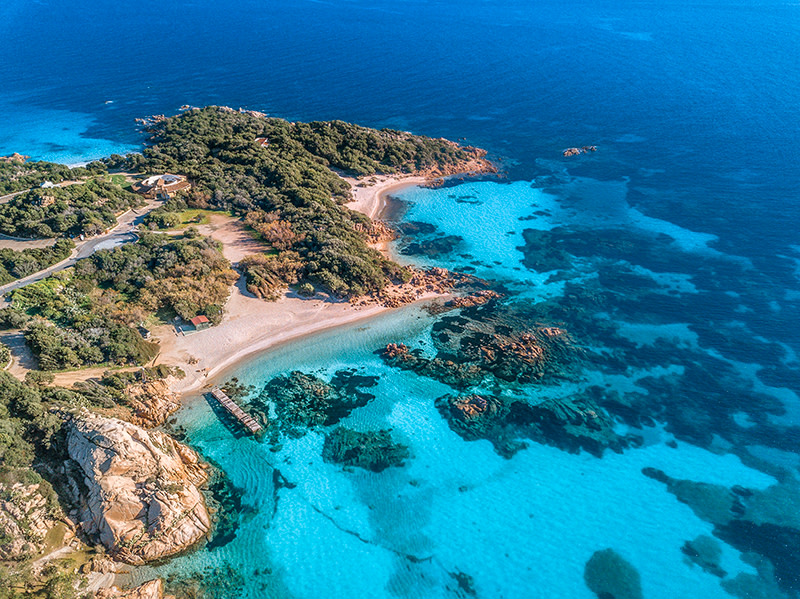 Spiaggia Capriccioli
Spiaggia CapriccioliLiscia Ruja
Known also as Long Beach, Liscia Ruja, with its over 500 meters of coastline, is the largest and most equipped beach in the area. Immersed in the fragrant greenery of a dense Mediterranean maquis characterized by the presence of rockrose, strawberry trees, and juniper bushes, Liscia Ruja is a true environmental paradise: on the western side (left) is the bay of Cala di Volpe, closed in front by the panorama of the islands of Soffi, Le Camere, and Mortorio, while on the right you can see the silhouette of Capo Figari, the open-air natural museum of the Golfo Aranci coastline. Compared to other beaches in northern Sardinia, Liscia Ruja presents some significant differences: its sand, although a bit coarser, is soft to the touch and has a suggestive light reddish color that with the sun takes on shades and golden reflections - this explains the meaning of its name, which is "red stripe". The crystal-clear waters have a beautiful emerald green color which, depending on the water level, becomes lighter or tends towards deep blue: the seabed is shallow near the shore but does not increase too rapidly as you venture further out. While maintaining a wild appearance, Liscia Ruja is a very popular beach frequented by young people - perhaps due to the fame gained from the August festival held here every year. Its sandy expanse is so vast that it allows for the coexistence of stretches of coastline with free access and bathing establishments that offer every service useful for bathing, including: rental of sun loungers and umbrellas, boats, pedal boats, and kayaks, ample paid parking, children's playgrounds, and numerous dining options - local eateries, proper restaurants, and some of the most prestigious hotels in Sardinia. Animals are not allowed, and the parking lot, with 80 parking spaces, is subject to a fee.
How to get there? From Porto Cervo, head south along SP94. Once you reach the Abbiadori area, continue on SP160 following the signs for Romazzino - Cala di Volpe. After passing the junction for Cala Volpe, take a slight right after about a hundred meters: from here, follow the dirt road marked with the indication "via Liscia Ruja". This access road, about two kilometers long, is lined with bushes on both sides, is not paved, and is somewhat narrow. To facilitate the passage of vehicles, especially during the high season when the influx of bathers is significant, a control system has been set up using a transverse barrier. After about two kilometers of travel on this slightly rugged road, you will arrive at the paid parking area where you can leave your car and reach the beach accesses on foot in just a few moments. From Olbia, instead, continue north on SP125. Then, take provincial road 37 towards Costa Smeralda® and, after a couple of kilometers, at the Porto Badisco junction, turn right. The road continues on SP94 until the intersection for Cala di Volpe: from here, turn right twice following the signs for Liscia Ruja. In addition to using local public transport, with the Lu Pustali bus that arrives at Liscia Ruja, a stop located just before the beginning of the unpaved dirt road, Liscia Ruja beach can also be reached by sea: with small rental or private boats, it is indeed possible to use the dedicated launching corridor located on the beach.
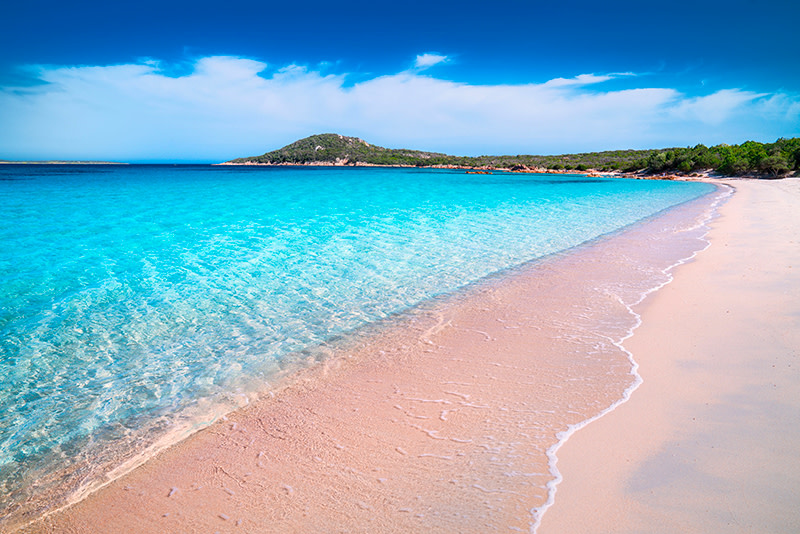 Liscia Ruja
Liscia RujaRena Bianca
Not to be confused with the homonymous beach of Santa Teresa di Gallura, the enchanting Rena Bianca, located 17 kilometers from Olbia and a short distance from its coastal villages San Pantaleo and Portisco, is one of the most iconic beaches of the northeastern Sardinian coast. Particularly striking is the surrounding natural environment. From the beach, in fact, you can admire the breathtaking panorama of the nearby coasts of the Gulf of Cugnana, embellished by the islets of Soffi, Mortorio, and Le Camere. The Rena Bianca beach takes its name from the whiteness of its sandy shore, which is crossed by dunes covered with the dense and luxuriant vegetation typical of the fragrant Mediterranean scrub. Protected at both lateral ends by small cliffs of reddish granite, Rena Bianca beach is known for its very fine and white sand, as well as for the transparency and color of its sea, which, from the early hours of the morning, takes on aqua-green reflections on the shore and on the rocky seabed, and emerald green further offshore. The very shallow and sandy seabed, almost completely devoid of seagrass, makes it particularly suitable for families with children and for underwater diving. Despite the numerous services offered to bathers - including refreshment points, rental of umbrellas and sunbeds, rental of canoes, jet skis, and pedal boats, as well as the possibility of renting all the equipment useful for windsurfing at the school on site - Rena Bianca remains a beach of pristine beauty dotted with small intimate and reserved corners. From the parking lot and from the left side of the beach, two trails depart that cross the northern promontory and lead to a small sandy arch called Lu Stagnu Longu.
How to get there? From Olbia, head north along the SS125 Orientale Sarda and then take the SP73 towards Costa Smeralda®. After a few kilometers, turn right at Portisco and enter the provincial road 94 which follows the coastline. After passing the nearby Liscia Ruja beach and the famous granite boulder with the inscription Costa Smeralda®, continue for about a kilometer to find the entrance to Rena Bianca, well marked by a brown sign indicating to turn onto a dirt road and continue for about 300/500 meters until you reach the parking lots. From there to the beach, it takes about a 3/5 minute walk.
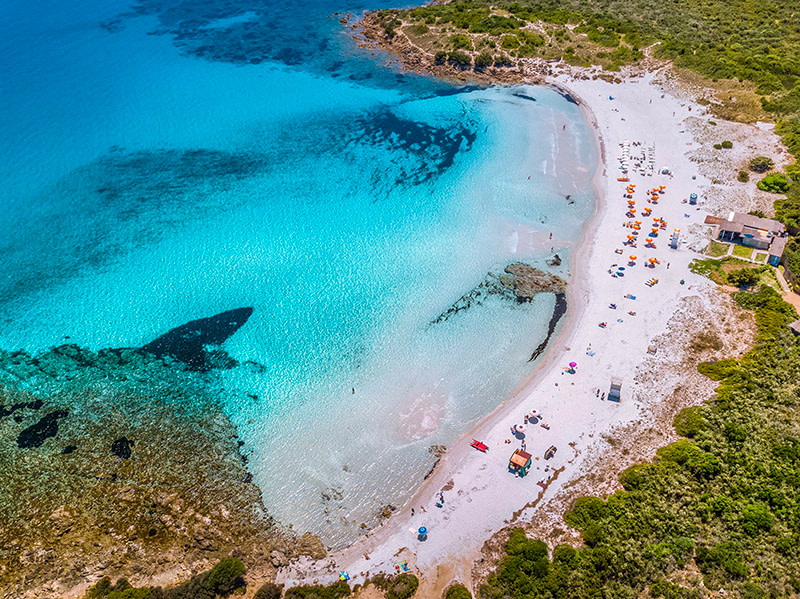 Rena Bianca
Rena Bianca






